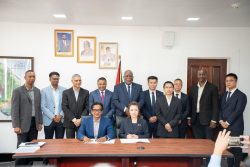-defends Grow More Food results
The Guyana Marketing Corporation (GMC) says it is currently undertaking studies to identify new markets and new products that have export potential beside the identified 4P’s: pepper, pumpkin, plantain and pineapple.

“The government has recognized that markets are essential for farmers since domestic production exceeds domestic needs”, the agency’s head Nizam Hassan wrote recently in a letter to Stabroek News. He was responding to a series of articles in this newspaper on the Agriculture Ministry’s ‘Grow More Food’ campaign as well as a recent editorial on the campaign. In the series, one of the main complaints by farmers was the lack of markets.
“These studies will build on the existing market information that is available at the GMC thus enabling Guyana to increase its non-traditional exports in the near future”, Hassan said adding that the collection of farmers’ production data is crucial to this process. However, he said that despite the constant plea to farmers to provide their production information, many farmers have not returned the forms with their data. “It must be emphasized, that farmers not on the GMC’s database cannot be linked to buyers and as such will not be able to source these new markets”, he said.
According to Hassan, apart from visits and phone calls to farmers, letters are also sent to them requesting their production information. More than 4000 return postage-paid letters were sent to farmers in the first half of 2010 but less than 100 forms were returned, he said.
The GMC is the lead agency coordinating the Grow More Food Campaign aimed at national and regional food security as well as improving the economic status of farmers. Several regional and multilateral institutions have hailed the campaign and used it as an example for several Caricom states, Hassan said. He said that among the objectives of the campaign were to ensure Guyana’s food security during the period, 2007 to 2008, when rising fuel prices were causing food prices to rise and food was becoming less accessible to many persons globally and to maintain its presence in existing markets and captitalise on new market opportunities.
Hassan said that the campaign was launched under a ‘market-led’ approach in 2008 and consisted of a five-step plan. This included the implementation of a US$21.9M Agricultural Export Diversification (ADP) Project, currently ongoing through the Agricultural Sector Development Unit (ASDU) of the Ministry of Agriculture. Key aspects of this project include the formation of three clusters; fruit and vegetables, aquaculture and livestock. “This project aims to increase Guyana’s export growth rate and reduce its volatility by focusing on developing commodity chains on non-traditional agricultural products through the value chain approach”, Hassan said.
The second step is the implementation of US$6M Rural Enterprise & Agricultural Development (READ) project currently ongoing by the ASDU with key aspects being to work with rural communities to build their capacity to capitalize on market opportunities. “The overall goal is to improve the livelihood of vulnerable communities”, Hassan said.
The third step is increased investment in drainage and irrigation including restoring drainage to areas abandoned by farmers. Over the last two years more than $5 billion has been spent and farmers trained to manage the maintenance of rehabilitated structures, Hassan said. The fourth step is the enhancement of the extension service and through the acquisition of vehicles, more qualified officers from Cuban and other agricultural institutions, and training for all of the Ministry of Agriculture’s staff, they are more capable of responding to the farmers’ needs and bridging the gap between farming and the transfer of technology, Hassan said. Sometimes, he said, at meetings between officials of the Ministry of Agriculture and its agencies and farmers, sometimes more officials than farmers are present.
Seed and planting
materials
The other step is the increased availability of seed and planting materials. This and improved livestock breeds has led to the increase of food availability both for local consumption and for export, Hassan said.
He pointed out that a comparison of the exports of the top primary products reveals that the exports have increased for most of the commodities ranging from 2.7% in the case of pumpkin to as high as 949% in the case of coconuts, when comparing the end year volumes in 2007 to those of 2009. As a result of the work undertaken by the government through the Grow More Food campaign, exports for the Other Crops sector since the campaign have increased by 32.4% i.e., from 7116 metric tonnes in 2008 to 9423 metric tonnes in 2009. “Further for the first half of 2010, exports currently stand at 7,640 metric tonnes, i.e., more than the overall total for 2008 and are projected to exceed those of 2009. These increases have mostly gone to our traditional markets but new markets have also been tapped into since the campaign, such as the Dominican Republic and Aruba”, Hassan said.
He said that as a result of the ADP, more emphasis is being placed on the Other Crops Sector, which is the production of fruit and vegetables especially as it relates to value added products within this sector. He said that the Ministry has been collaborating with the Guyana Agro Processors Association (GAPA), the Pomeroon Women Agro-Processors Association, EMPRETEC, the Rural Women Network (RWN), and other private sector individuals to expand agro-processing so as to reduce wastage among farmers. Government agencies such as NARI, GSA, and GMC have been providing research, training and marketing support towards this initiative, according to Hassan.
He noted that at the end of 2009 the value of agro-processing exports stood at $US3.4M and some of the major agro-processing commodities currently being exported are copra, heart of palm, coconut oil (crude), pineapple chunks and sauces.
Hassan emphasized that government is constantly seeking new markets for agricultural products but this is not an easy task as “our own sister states are proving very tough markets to access”. The New GMC Head said that at the Caricom level- at the meeting of agricultural ministers, this has been a sore issue with calls for the facilitation of trade within the region. “We have even had the formation of a ministerial sub-committee comprising of ministers of agriculture of Guyana, St Lucia and Trinidad and Tobago to deal with the facilitation of agricultural trade”, he said.
“Amazingly in a free trade zone within Caricom, we have to seek to establish protocols with countries to trade in specific products and this comes with a cost, as we have to bring their agricultural officials to visit the farms on a regular basis. This is not the case for exports to countries outside of Caricom”, Hassan further disclosed.
Standards
“Another issue is the standards that are required of us. With the elimination of tariffs, countries are utilizing more non-tariff barriers to prevent trade and the farmers must understand that we have to comply with these conditions. So when we say we want a product with uniform size, certain packaging requirements and which must be cultivated under certain conditions, it must be understood that these are the requirements of the buyer”, he said. “Sometimes it is hard to change the mindset of farmers. So this has to be a gradual process, getting the farmers to conform to these standards”, the New GMC head added.
“So one must understand that even though we have invested so much in agriculture this is not a process where you will see results immediately. There are some results that will be noticed immediately, but the major goals will be achieved in the future”, Hassan said. He stated that the implementation of some of the major components of the Grow More Food campaign is work in progress and many of these plans are long term.
“One can understand the frustration of several farmers, but in a developing country with a scarcity of resources, one has to allocate these resources optimally to achieve the best results, and of course some persons will not immediately benefit from this, but I can assure you that for every farmer that is not satisfied there are tens more who have benefitted for our investment. Yes, there are access roads which are in need of dire repairs. We cannot ignore the fact that the Ministry of Public Works and the Regional Development Councils have been spending resources to improve these. If we had not had a long period of economic decline and neglect of agriculture, our country would have had all the resources to fix every access dam and other needed facilities in every part of Guyana”, Hassan said.
“I would hope that Stabroek News would continue to monitor our progress and I assure you that all our goals would be achieved and Guyana would continue to maintain its position as the only food secure nation and a major agricultural player within the region”, he added.
He had referred to some agro-processing activities and said that others were in the pipeline.
Hassan said that as a result of increased production from the campaign, exports have expanded as well as agro-processing so as to ensure markets for farmers both locally and internationally. Government continues to train farmers so as to enhance their skills and intelligence and ensure that they are not exploited by the ‘middle man’, he also pointed out.
Hassan said that data from the Guyana Office for Investment (Go Invest) shows that in 2007, 67 agricultural projects were being developed and at the end of 2009, 152 agricultural projects were being worked on. This clearly shows that more individuals and companies are investing in agriculture and its associated businesses, he said. “With the global situation being susceptible to repeated food price shocks, we can only encourage our farmers to become market oriented, adopt the new production technologies and Grow More Food”, he concluded. Agriculture Minister Robert Persaud had recently told farmers not to plant unless they have a market for their produce.









